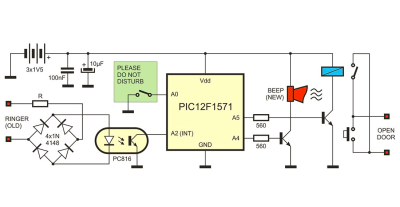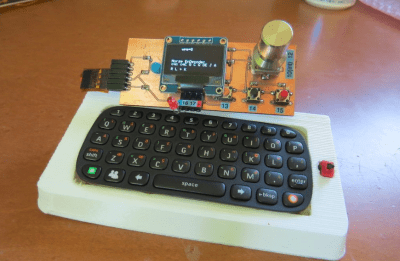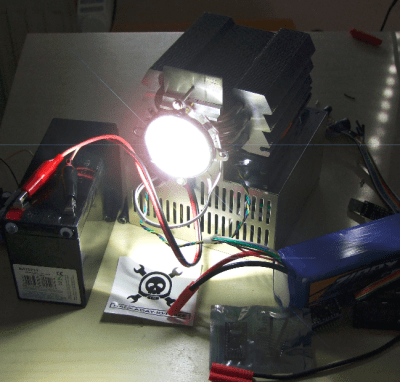With over 160 years of history under its belt, Morse code is by far the oldest digital signaling system known to man. Originally developed for telegraph systems, [Samuel Morse’s] code has been sent over wires, via radio, and even with flashes of light. Hackers, makers and engineers have been working with Morse code throughout history. For many years, simple code keys and practice oscillators were the “hello world” of hobby electronics. In fact, a company which started out selling a Morse key has gone on to become one of the largest electronic component distributors in the world. The company still bears the name of that project: Digi-Key. This week’s Hacklet is all about some of the best Morse code projects on Hackaday.io!
 We start with [voxnulla] and Morse key HID + ugly hack. [voxnulla] found an old key at his favorite thrift store. It was dusty, greasy, and for some reason had been painted hospital green. Once the paint and grime were removed, and the original wooden plate restored, the key actually looked pretty good. [Voxnulla] then decided to turn it into a USB Human Interface Device (HID), emulating the keyboard of his computer. An Arduino converts Morse code characters tapped at the key into keystrokes over USB. As [voxnulla] knows, when butterflies aren’t available, real programmers drive vim with a Morse key!
We start with [voxnulla] and Morse key HID + ugly hack. [voxnulla] found an old key at his favorite thrift store. It was dusty, greasy, and for some reason had been painted hospital green. Once the paint and grime were removed, and the original wooden plate restored, the key actually looked pretty good. [Voxnulla] then decided to turn it into a USB Human Interface Device (HID), emulating the keyboard of his computer. An Arduino converts Morse code characters tapped at the key into keystrokes over USB. As [voxnulla] knows, when butterflies aren’t available, real programmers drive vim with a Morse key!
 Next up is [Voja Antonic] with Daddy, I don’t have the key. If you didn’t read [Voja’s] article about Hacking the Digital and Social System, check it out! Many apartments have an intercom system where you have to “buzz” someone in, activating a solenoid lock in the door. [Voja] inserted a Microchip PIC12 series microcontroller between the speaker and the unlock button. All a user has to do is tap out the right Morse code password on the call button in the lobby. If the code is accepted, the PIC unlocks the door, and you’re in!
Next up is [Voja Antonic] with Daddy, I don’t have the key. If you didn’t read [Voja’s] article about Hacking the Digital and Social System, check it out! Many apartments have an intercom system where you have to “buzz” someone in, activating a solenoid lock in the door. [Voja] inserted a Microchip PIC12 series microcontroller between the speaker and the unlock button. All a user has to do is tap out the right Morse code password on the call button in the lobby. If the code is accepted, the PIC unlocks the door, and you’re in!
 [kodera2t] took things into the digital age with Stand-alone Tiny Morse code encoder/decoder. This project grew out of his general purpose Portable tiny IoT device project. [kodera2t] rolled his own Arduino-compatible board for this project. The tiny ATmega1284 powered computer allows him to encode and decode Morse code. A smartphone-sized keyboard and a lilliputian OLED display serve as the user interface, while rotary encoder allows for variable code speed. You can even “tap” Morse out on one of the tactile buttons!
[kodera2t] took things into the digital age with Stand-alone Tiny Morse code encoder/decoder. This project grew out of his general purpose Portable tiny IoT device project. [kodera2t] rolled his own Arduino-compatible board for this project. The tiny ATmega1284 powered computer allows him to encode and decode Morse code. A smartphone-sized keyboard and a lilliputian OLED display serve as the user interface, while rotary encoder allows for variable code speed. You can even “tap” Morse out on one of the tactile buttons!
 Finally, we have [Yannick (Gigawipf)] with Portable (morsing) 100W led flashlight. 100 watt LEDs have gotten quite cheap these days, and they’re perfect when you absolutely, positively have to blind everyone around you. These LEDs can also be switched on and off quickly, which makes them perfect for Morse code. In years past, mechanical shutters had to be used to perform the same feat. [Yannick] used a 5000mAh 5S Zippy Li-Po to supply electrons to this hungry beast, while a 600 Watt constant current boost converter keeps that power under control. An Arduino running Morse code converter software controls the boost convert and LED. [Yannick] uses his computer to send a message over the Arduino’s serial link, and the light does the rest, flashing out the message for all to see.
Finally, we have [Yannick (Gigawipf)] with Portable (morsing) 100W led flashlight. 100 watt LEDs have gotten quite cheap these days, and they’re perfect when you absolutely, positively have to blind everyone around you. These LEDs can also be switched on and off quickly, which makes them perfect for Morse code. In years past, mechanical shutters had to be used to perform the same feat. [Yannick] used a 5000mAh 5S Zippy Li-Po to supply electrons to this hungry beast, while a 600 Watt constant current boost converter keeps that power under control. An Arduino running Morse code converter software controls the boost convert and LED. [Yannick] uses his computer to send a message over the Arduino’s serial link, and the light does the rest, flashing out the message for all to see.
If you want more Morse goodness, check out our brand new Morse code project list! My Morse is a bit rusty, so if I wasn’t able to copy your transmission and missed your project, don’t hesitate to drop me a message on Hackaday.io. That’s it for this week’s Hacklet. As always, see you next week. Same hack time, same hack channel, bringing you the best of Hackaday.io!

















Once you Morse yourself into the lobby, how do you get into the apartment without a key?
With a secret knock knock?
Transmitted by pipes, walls, overturned hulls, and many other media. Smoke!
The door latches operable till opened (I guess) maybe, anyway he’s hooked into it.
By far the oldest ? The Romans used fire towers to transmit digital signals, and the method probably pre-dates them.
And the plains Indians used smoky fires and wet blankets to transmit smoke signals. One could probably do Morse that way — long and short smoke puffs.Likely hazardous to health though.
“The Romans used fire towers to transmit digital signals”
This is quite the techno-geek-historical hornets nest you mentioned there.. “Is a fire tower relay system a digital system?”
I’m afraid I have to say “no”, because these systems would be used in two possible ways. The first being the simple warning “Fire” for trouble and “dark” for A-OK. Which of course is digital in the sense that it is a binary in choice and rather discreet in execution. But the problem is that the message is determined in advance “off == cake” and “on == swords”, and the duration/interval is pretty analog.
The other possible usage a fire-tower could have had was by means of semaphore. The distance of the beacons and the lack of optical technology would have made discreet signalling very difficult even in optimal weather conditions. The set of possible messages would therefor had to be limited, which renders the set of actions to mere symbols and thus not very digital in nature. I don’t think this system would be very reliable across the vast plains and mountains of the Limes with all it’s various climatological differences, So I think the messages would be very limited to a simple call-sign, a status flag and perhaps some direction, but this seems a stretch for that technology.
I believe there were several discreetly signaled general purpose communication methods before Morse Code out there which could be labeled as digital or binary, but the Romans probably did not use these in their military apparatus.
This might answer some of your questions:
https://en.wikipedia.org/wiki/Hydraulic_telegraph#Greek_hydraulic_semaphore_system
Clicks, beeps, flashes of light, puffs of smoke – how about eyelids?
https://www.youtube.com/watch?v=BgelmcOdS38
Jeremiah Andrew Denton, Jr. (July 15, 1924 – March 28, 2014) was a Rear Admiral and Naval Aviator in the United States Navy and, following his retirement from naval service, was a United States Senator from the state of Alabama.
He spent almost eight years as a prisoner of war (POW) in North Vietnam and later wrote a book that became a film about those experiences. Denton is best known from this period of his life for the 1966 televised press conference in which he was forced to participate as an American POW by his North Vietnamese captors. He used the opportunity to communicate successfully and to confirm for the first time to the U.S. Office of Naval Intelligence and Americans that American POWs were being tortured in North Vietnam. He repeatedly blinked his eyes in Morse code during the interview, spelling out the word “T-O-R-T-U-R-E”.
[Source: Wikipedia]
I do a lot of light control programming for a company called Alliance Studio (they use EFX-TEK boards in lots of their displays). One one display for the game, Firefall, there are male and female military characters. As I use the Propeller and had a spare cogs, I added Morse code IFF output from each (both had LEDs on the backs of their uniforms). It was kind of a last minute add, but the owner of Red-5 Studios loved it. Morse code may be old, but never gets old.
You can see a picture of the display there (three Propeller chips in total running it).
— http://forums.parallax.com/attachment.php?attachmentid=84574&d=1314418483
My project ” Stand-alone Tiny Morse code encoder/decoder ” changed to https://hackaday.io/project/8071-morse-code-endecorder , please modify it and thanks in advance!